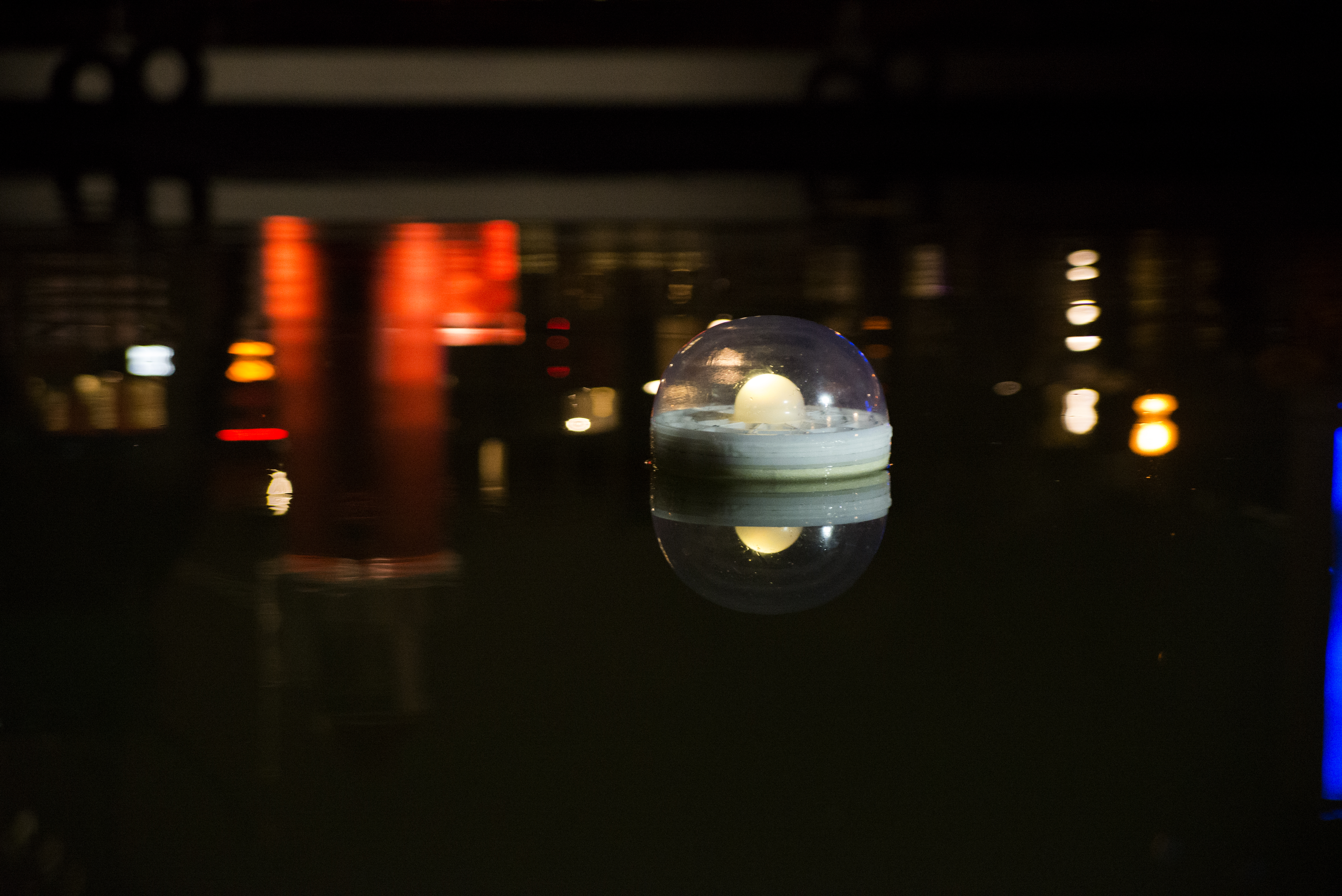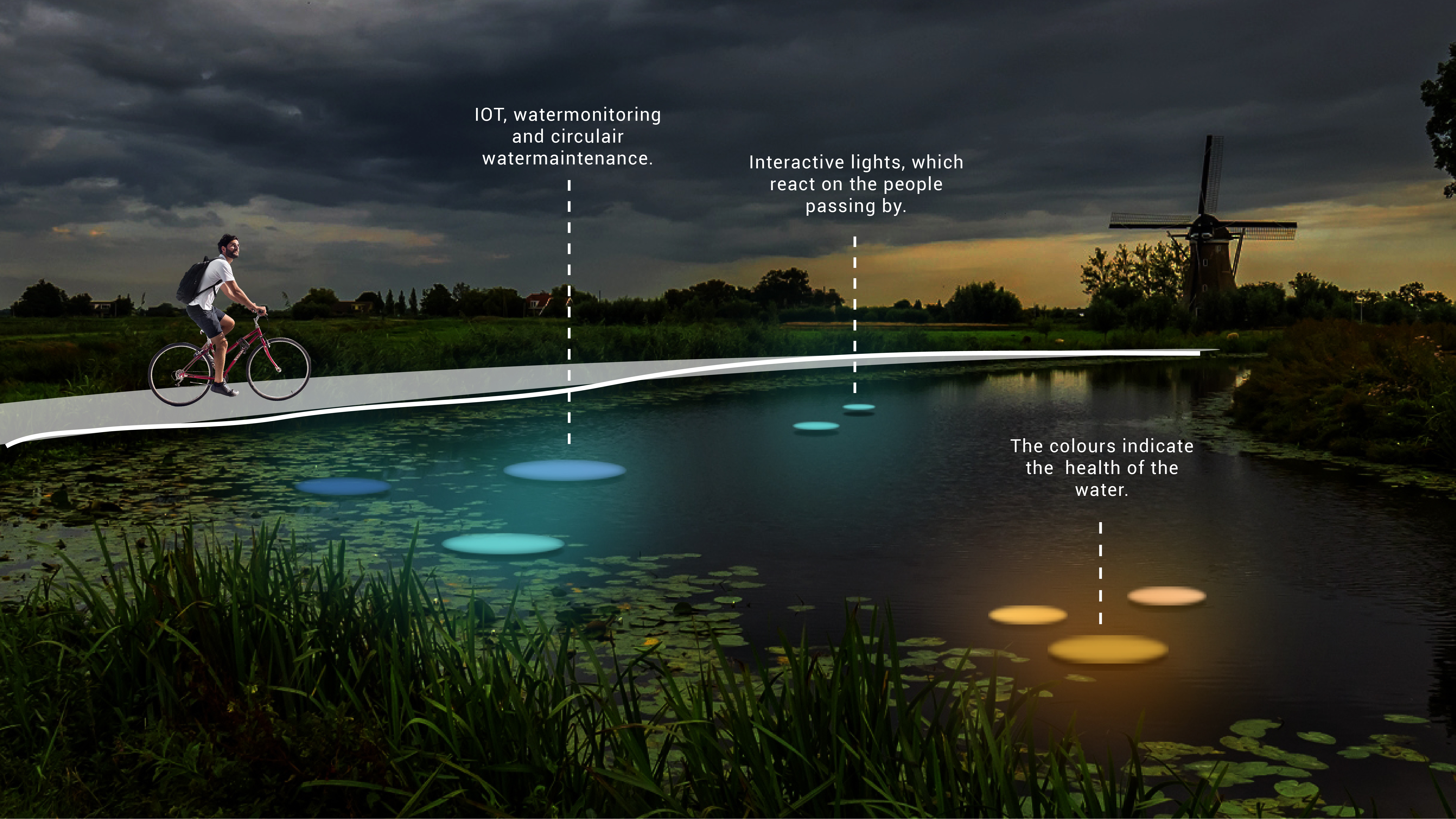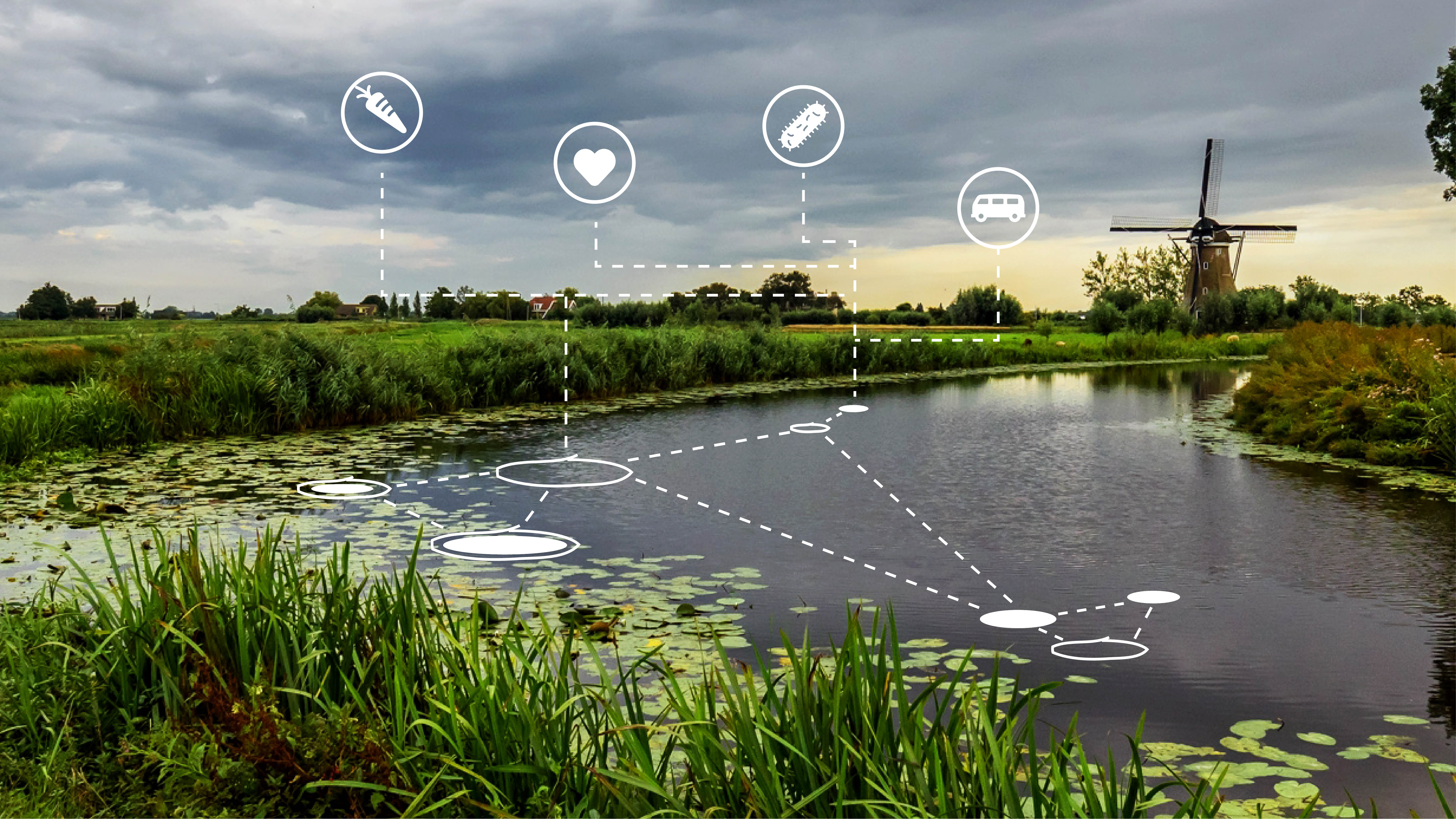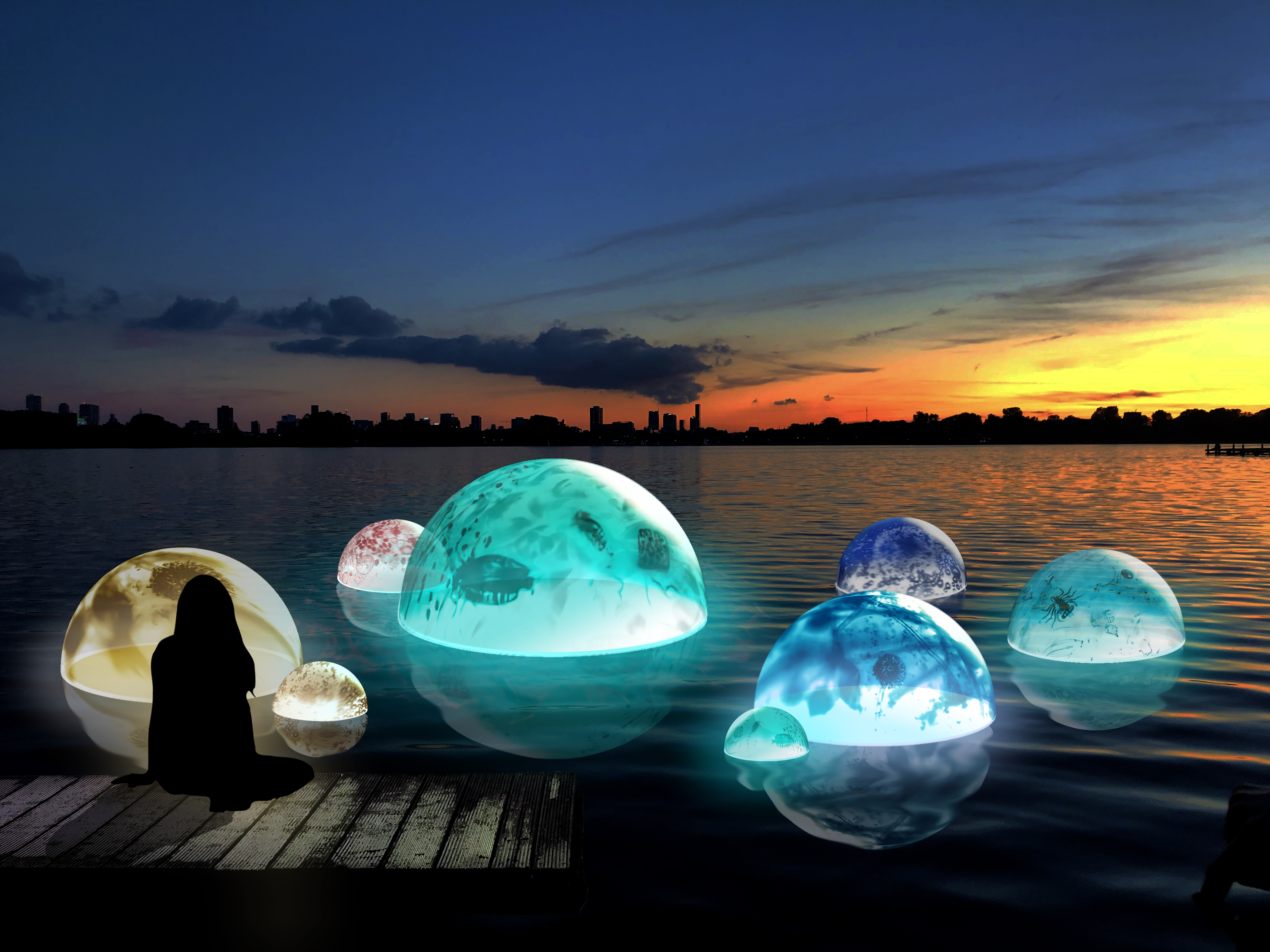Have you ever gone a day without water? Most likely you have experienced low energy levels or fatigue after a few couple of hours. Water gives us energy. More than that, water is our most fundamental source of life that we need to care for. This sentiment is echoed by the collaborative project of Nova Innova and Water Sensitive: POND.
POND is a floating network on water that not only generates energy from polluted wastewater but visualizes the water quality with color-coded light domes on the water. With the use of Microbial Fuel Cell technologies organic compounds are broken down by microbes in the water. This then releases electrons. It becomes a natural cycle of energy production. The energy is used to light up the domes in various colors indicative of the water quality while simultaneously functioning as large microscopes magnifying the underworld for an interactive experience.
For now, the project is still in the prototyping stage before it sets out to launch on actual waters. We already got in touch with designer of the Living Light and co-founder of Nova Innova, Ermi van Oers, to hear more about her inspiration and the future potential of this spectacular symphony between light and water.
POND not only makes use of an innovative technology to produce energy in a sustainable manner but engages the audience in a captivating performance of light and water. What inspired the practical and poetic agenda of POND?
It all started during my studies at the Willem de Kooning Academie in Rotterdam. I dove deep into bio design, specifically into human waste to find out how we could turn it into something valuable. I was most interested in domestic wastewater. Despite its value, it is such a huge source of waste simply disregarded by humans. I wanted to research different ways to deal with domestic waste water instead of just throwing it down the drain. Essentially, answering the question: What can you use it for? I came across a scientific article that showed how we can harvest energy from urine with the use of Microbial Fuel Cell Technology. I wanted to learn more about it so during my studies together with a classmate I experimented with all kinds of sources next to urine like organic waste, mud and water. We had one small cup of port water with which we managed to already light up two LEDs - just from the microbes. Consequently, I made the very first prototype of POND which was the ‘Microbial Light’: a floating light harvesting energy from the port water of Rotterdam. Back then the light was symbolizing a floating house with a similar shape to the Floating Pavilion in Rotterdam. So we thought if we can light up one small LED from such a small surface imagine ‘what if you power a floating house with the domestic waste water and portwater itself?’ This initial prototype also served a first test for myself whether I would be able to work with this technology as a designer.

Shortly after, I shifted my focus towards plants as I started the Living Light Project in collaboration with Plant-e from Wageningen. As we were prominently occupied with the Living Lights projects, the floating lights were temporarily put on hold. Around half a year ago, we started picking it up again due to the potential of the technology. We learned a lot about harvesting energy from plants, so we wanted to go back to floating lights to apply this knowledge and really transform POND into something functional. What if the waters could be our future power plants?
As a team we have big dreams. Then we take a step back and start with small applications. These applications show the beauty, magic and potential of the technologies before we can actually scale up the innovation. POND shows how it is already possible to harvest energy from water while at the same time showing the well-being of the water. This is how it started.
What is the main message you want to convey with POND? What are you hoping for people to get out of it?
There are a couple of things I want to convey. First of all, we want to show that water is a living organism not just an object. Water is something we need to care for. It is incredibly important for the whole world and ourselves. We really need to take better care of our water to keep it healthy and keep everything including ourselves alive. However, since we cannot communicate directly with water, we fail to recognize it as a living organism. That is the reason why we want to give it a voice. On the one hand, we want to foster the connection between human and water.
One the other hand, we want to show that you can actually work together with nature to meet our demands. We do not have to get our energy from coals and rely on linear systems. We can actually cooperate with nature to fulfill their and our needs. Hence, we work a lot with the Microbial Fuel Cell Technology to really show what is possible. For now it might only produce a little bit of energy but once it is actually taken out of the lab, we can develop the technology much quicker and into something bigger.
Beside the energy production, you can measure the water quality and send the data to the municipality and the water embassy. With this information, you can actually also take better care of the water – and they can take better care of the water. So, it has a lot in it. It is not one or the other but it is actually the entirety of the concept that brings us a step forward.
How do you envision the communication between the non-human entity of water and humans? What exact information about the water are you hoping to transmit?
The first pilot that we are working on right now visualizes the data by the colors of the lights domes. You do not need an app but you receive the information directly by looking at the lights. You know immediately how well or bad the water is doing just by looking at the colors. We do not exactly know which colors will indicate which state of the water quality, yet, but you can imagine if it lights up red it will most likely mean that something is wrong, and you probably should not swim there. Currently, we are in contact with the different water boards (regional water authorities; in Dutch: Waterschappen) to get a better idea of what exactly water quality is. What do we need to know about water? What does the embassy of water want to know about water? Based on this conversation, we will determine which sensors to connect and what type of data we need to generate.
Next to this technical data, we want to amplify the beauty of the water world. With the domes, the surface of the water gets magnified. When there is a little insect or some water wrinkles for example, you can observe all these happenings projected on the dome itself. The giant domes acting as microscopes show how beautiful the water is and show many living organisms are actually housing in the water. Something which you cannot usually see with your bare eye.

Who are you designing POND for? How were the reactions of the spectators so far?
Until now, we have mostly been talking with a lot of water companies. Their reactions are really positive. On the one hand, they really like the functional components. So far, they had to measure the water quality by taking numerous samples which then go to the lab before somebody analyzes and interprets them. With this technology, they can measure the water quality much smarter and faster. This technology provides much more data on various parameters. For example, the state of the blue algae which makes water very toxic for humans, and hence dangerous to swim in. POND can predict and transmit this information immediately.
On the other hand, there is a lot of added value in promoting water consciousness. Indeed, people that understand how important water is are also more inclined to care about it. The technical people of the companies are on board, as well the ones from the sustainability and climate disciplines. So, it is really nice to have this support from the companies as well as the positive reactions from the general public.
Your invention also produces small amounts of energy. Are you already in touch with actors in the energy sector?
We are actually about to have our first conversation with an energy firm. The conversation will mainly be about the Living Lights project but also in general about new energy sources. I am personally very curious about their reaction. What you often notice from energy companies or energy based companies is that they usually ask questions about how much voltage or energy the innovation produces. We answer: It is not more than a solar panel. So consequently, they question: why should we invest in it? Of course, they want to solve the energy crisis today but I believe you can only save it by also thinking about the future and investing in the future. We really need to invest in these kinds of new technologies now; think about what is needed in the future and not only what is feasible at the moment.
Thirty years ago, the solar panel produced very little energy and people wondered why they should invest money in this technology. The solar panels were almost disregarded, but see where we are now with solar panels. I really feel like the technologies we are working with are at the point where solar panels were at back then. This is why we need design to show the potential and possibilities of these future technologies.

So far POND is still in an initial prototyping phase. How do you think POND can move from prototype to reality? How do you envision the future of POND?
I really hope that our future cities are not connected to industrial metabolisms but to natural metabolisms. Coal power stations transform into beautiful lakes. Water can replace our former power plants and secure places for water and nature around us. As the technology provides more electricity and increasing profits, water will gain more in economic value as well. In the future I hope we see nature as more than just ‘there’. We take it for granted. The current attitude is that we can better build a house on a piece of land, as that provides more utility and profits. However, this attitude will not help us solve the climate crisis. We really need to make more space for nature.
Water will have an increasing economic value as well, and I believe POND is going to help with that. As mentioned before, I really want to show how to give nature a voice. We will create more empathy for it and by having more empathy for something we will take care of it. If nature takes care of us and we take care of it, we can establish a symbiotic system again. We have a mutual dependence and I really think we need to recognize that to solve our problems today. We do not believe in a story of economic growth and money but we actually believe in a story of being part of our ecosystem and that is the true value. POND is a small start to this story.
What message would you like to communicate to other practitioners and designers?
I think it is really important to take responsibility as a designer. We can make beautiful things but with that we only stimulate overconsumption. Our role is actually to bridge the gaps between different fields. We need to cross these different fields to come up with innovative ideas and solutions to make the world a better place. A better place to help the climate crises. We have to take action so fast because if not now it will be too late. So everybody has to pitch into that.

Share your thoughts and join the technology debate!
Be the first to comment